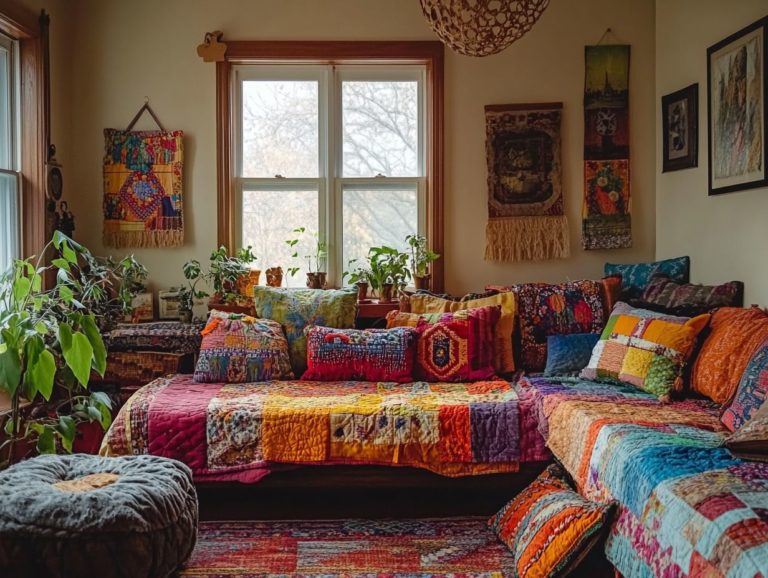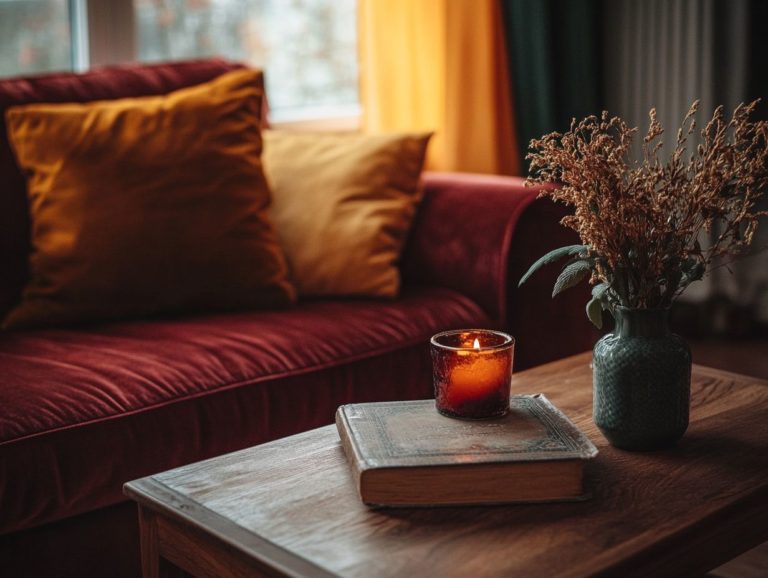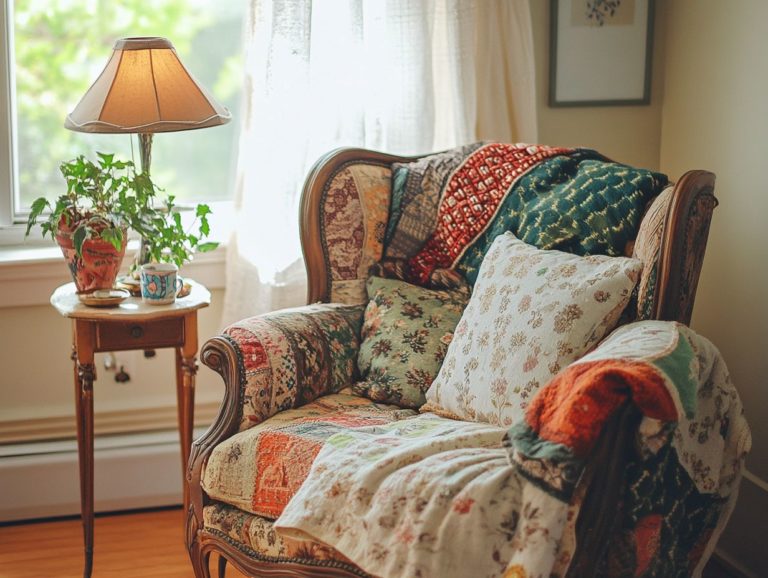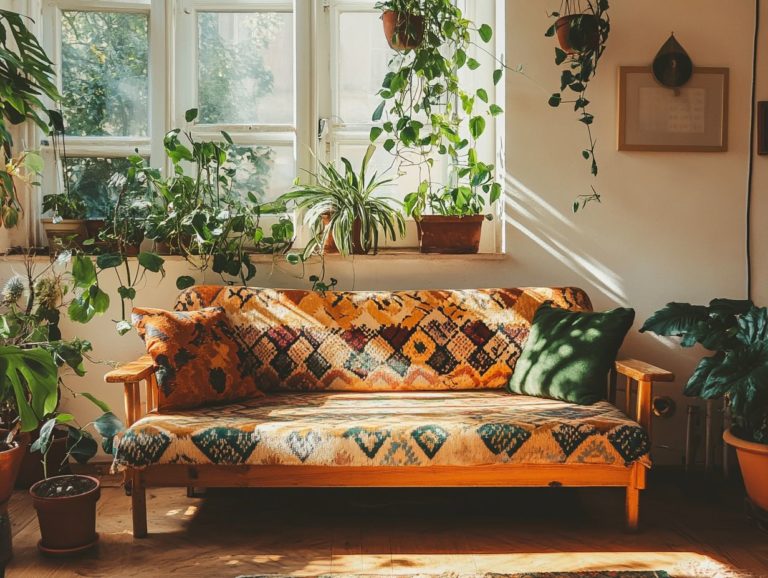The Best Vintage Fabric Patterns for Curtains
Vintage fabric patterns infuse a timeless charm into your home decor, especially when they grace your curtains.
From the delicate allure of floral prints to the striking impact of geometric designs, each pattern unfolds its own narrative. This article delves into popular vintage fabric patterns, including stripes, checks, and toile, as well as an array of luxurious fabric options cotton, linen, silk, and velvet that can truly elevate your space.
You will discover tips on how to incorporate these patterns seamlessly into your home for an effortlessly stylish and cohesive look.
Contents
- Key Takeaways:
- What Defines a Vintage Fabric Pattern?
- Popular Vintage Fabric Patterns for Curtains
- Fabric Options for Vintage Patterns
- How to Incorporate Vintage Fabric Patterns in Your Home
- Frequently Asked Questions
- What are the best vintage fabric patterns for curtains?
- What makes these vintage fabric patterns ideal for curtains?
- Can vintage fabric patterns be used for modern homes?
- Are these vintage fabric patterns suitable for all types of curtains?
- Where can I find the best vintage fabric patterns for curtains?
- What are some tips for choosing the perfect vintage fabric pattern for curtains?
Key Takeaways:

- Floral prints, geometric designs, and stripes/checks are popular vintage fabric patterns for curtains, adding a touch of nostalgia and charm to any room.
- Cotton, linen, silk, and velvet are great fabric options for vintage patterns, providing a timeless and elegant look.
- Mix and match vintage fabric patterns with confidence, using tips like choosing complementary colors to create a unique and stylish look in your home.
What Defines a Vintage Fabric Pattern?
Vintage fabric patterns have unique designs that evoke nostalgia and charm. They often reflect trends from specific eras like the 1960s and 1970s.
Styles include floral patterns, geometric designs, and paisley motifs. Each adds to a vibrant aesthetic, enhancing any vintage setting.
By grasping the nuances of these fabric types, you can significantly enhance your furniture projects, enabling you to choose pieces that truly resonate with your desired vintage look.
Popular Vintage Fabric Patterns for Curtains
When you consider curtains, popular vintage fabric patterns often showcase floral designs, geometric shapes, and vibrant prints, each capable of becoming a striking focal point in any room.
These patterns bring retro charm and can instantly transform your space. They also enhance the mid-century modern aesthetic that many vintage decor aficionados cherish. Selecting the right fabric can truly elevate your interior design, infusing spaces with both nostalgia and sophisticated style.
Floral Prints
Floral prints stand as one of the most iconic designs in vintage fabric, renowned for their vibrant colors and intricate details. These prints evoke a sense of nostalgia, serving as a striking centerpiece in both modern and retro settings, making them perfectly suited for vintage chairs or sofas.
Their captivating history dates back to the 18th century, but it was during the 1960s and 1970s that these delightful patterns truly flourished, with bold, oversized blossoms dominating the fabric landscape. Imagine the stunning contrasts created by color combinations like deep reds paired with sunny yellows or soft pastels set against dark backgrounds they capture attention and invite warmth effortlessly.
Whether you re opting for a large-scale floral to make a bold statement or choosing delicate, small-scale designs to add subtle accents, these patterns seamlessly enhance a variety of furniture projects. They have the power to transform a simple piece of furniture into a work of art, each telling a story steeped in rich heritage.
Geometric Designs
Geometric designs in vintage fabric present a bold and dynamic aesthetic, showcasing angular shapes and vibrant color combinations that defined the 1960s and 1970s. These retro patterns can effortlessly infuse an eclectic touch into your furniture projects, making them a preferred choice for vintage decor connoisseurs.
The allure of these geometric motifs extends beyond their eye-catching visuals; they carry a rich historical significance that mirrors a time of artistic experimentation and cultural evolution. In contrast to the soft, flowing lines of floral prints, geometric patterns provide a structured, modern profile that can elevate various design schemes.
If you’re considering incorporating these patterns into contemporary settings, choosing fabrics like cotton twill or canvas with bold, repetitive shapes can result in striking statement pieces for your furniture design. Authentic vintage options such as barkcloth or tapestry can evoke nostalgia, enriching your interior with a narrative that seamlessly links the past and present. To explore more, check out the top 10 vintage fabric patterns to enhance decor.
Stripes and Checks
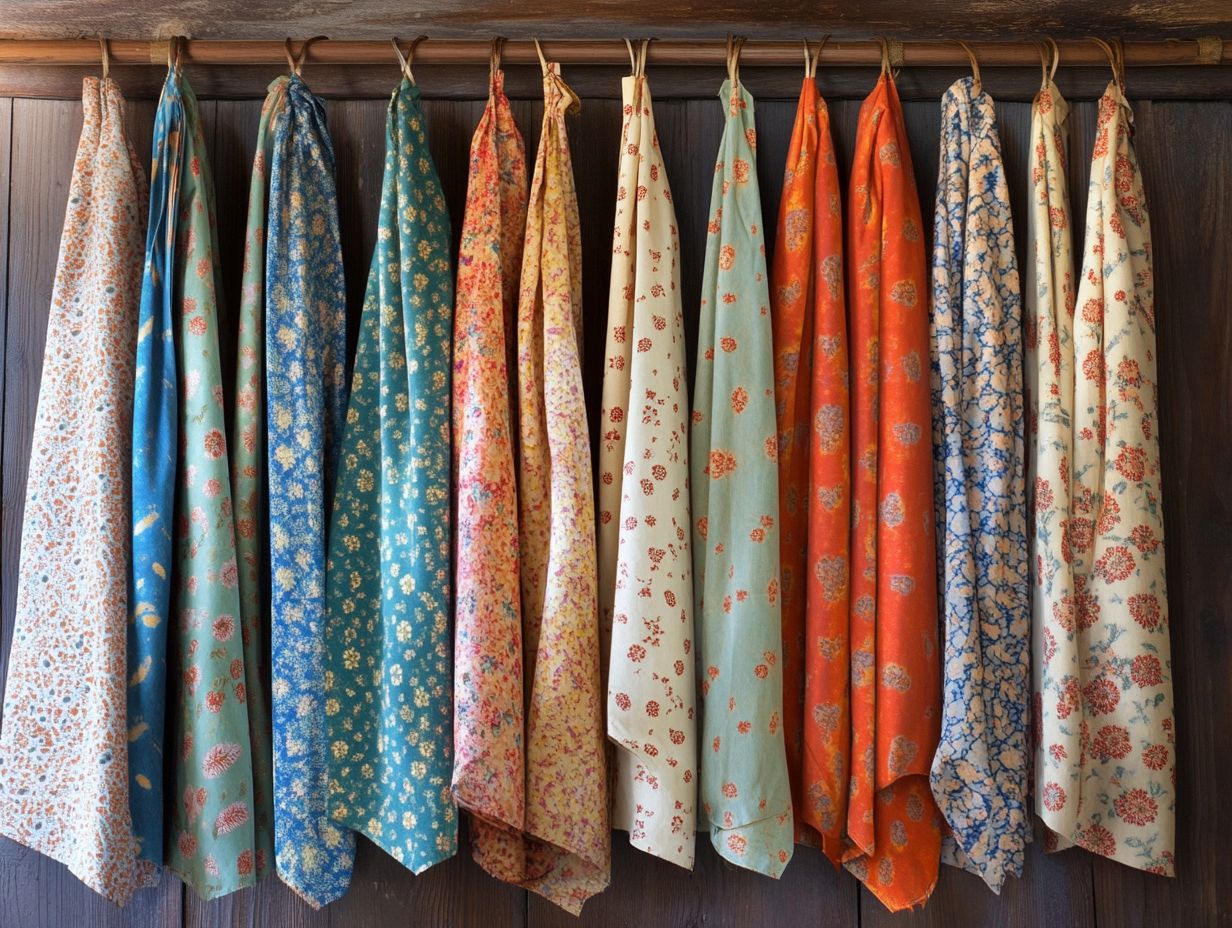
Stripes and checks are classic patterns in vintage fabric, often linked to traditional upholstery projects. They exude a timeless charm. Use these patterns to create a cohesive aesthetic while adding depth to your vintage space, whether it s a vintage sofa or a charming chair.
When you combine stripes and checks with floral and geometric designs, you create a rich tapestry of visual interest that elevates the overall ambiance. For example, pairing a bold navy stripe with delicate pastel florals conjures a delightful and eclectic vibe.
Checks in warm earth tones complement geometric prints beautifully, striking a harmonious balance that invites both comfort and style. Fabrics like cotton and linen absorb these vibrant patterns exquisitely, making them ideal for curtains, cushions, or even table linens.
Mix these diverse designs to achieve a stunning retro look that feels both nostalgic and refreshingly modern.
Toile
Toile is a timeless vintage fabric pattern known for its intricate designs, often illustrating pastoral scenes. This fabric style enhances the vintage aesthetic, creating a charming atmosphere that perfectly complements traditional decor.
Originating in 18th-century France, toile reflects the artistry of that era, showcasing scenes from rural life in one or two colors against a lighter background. These unique features contribute to its enduring allure, allowing it to find a cherished spot in various vintage fabric collections.
When designers incorporate toile into upholstery, they tap into a sense of nostalgia, often pairing it with solid colors or complementary prints. This ensures that the detailed imagery stands out without overwhelming the overall design.
Don’t miss the chance to create a cohesive decor by thoughtfully combining toile with other fabrics like linen or cotton. This approach elevates the visual appeal of your space and infuses it with a rich sense of history and storytelling.
Fabric Options for Vintage Patterns
When choosing fabric options for your vintage patterns, explore various fabric types like cotton, linen, silk, and velvet. Each of these materials brings unique qualities that impact both the look and durability of your project.
High-quality fabrics not only elevate the design but also guarantee longevity, making them perfect for upholstery projects that seek to capture timeless vintage charm.
Cotton
Cotton emerges as a versatile and durable choice among vintage fabrics, celebrated for its breathability and ability to retain vibrant colors. This makes it an excellent option for your upholstery projects. Whether you favor floral motifs or geometric patterns, cotton enhances both comfort and visual appeal in your space.
What truly sets cotton upholstery apart is its ease of cleaning; maintaining its pristine appearance requires only simple washing or spot treatments. Unlike synthetic fabrics, which tend to cling to odors or stains, cotton’s natural fibers effectively repel dirt and grime, making it a perfect fit for high-traffic areas.
While linen may offer a luxurious touch, it often comes with the drawbacks of wrinkling easily and being more challenging to clean. Cotton strikes the ideal balance between comfort and practicality, ensuring that style and functionality coexist beautifully in any vintage setting.
Linen
Linen is an exceptional fabric choice for your vintage upholstery. It has a natural texture and earthy tones that bring a relaxed elegance to any space.
Its breathability and durability make it perfect for both casual and formal settings. This versatile fabric develops a charming patina over time, enhancing its character.
Linen also helps regulate temperature, ensuring comfort in cozy sitting rooms and formal areas alike. It requires gentle care; a simple wash with mild detergents and air-drying will maintain its quality.
By following these guidelines, your vintage upholstery will retain its exquisite look for years to come. Linen is a smart investment for any decor enthusiast, especially when you explore popular vintage fabric patterns that can elevate your style.
Silk
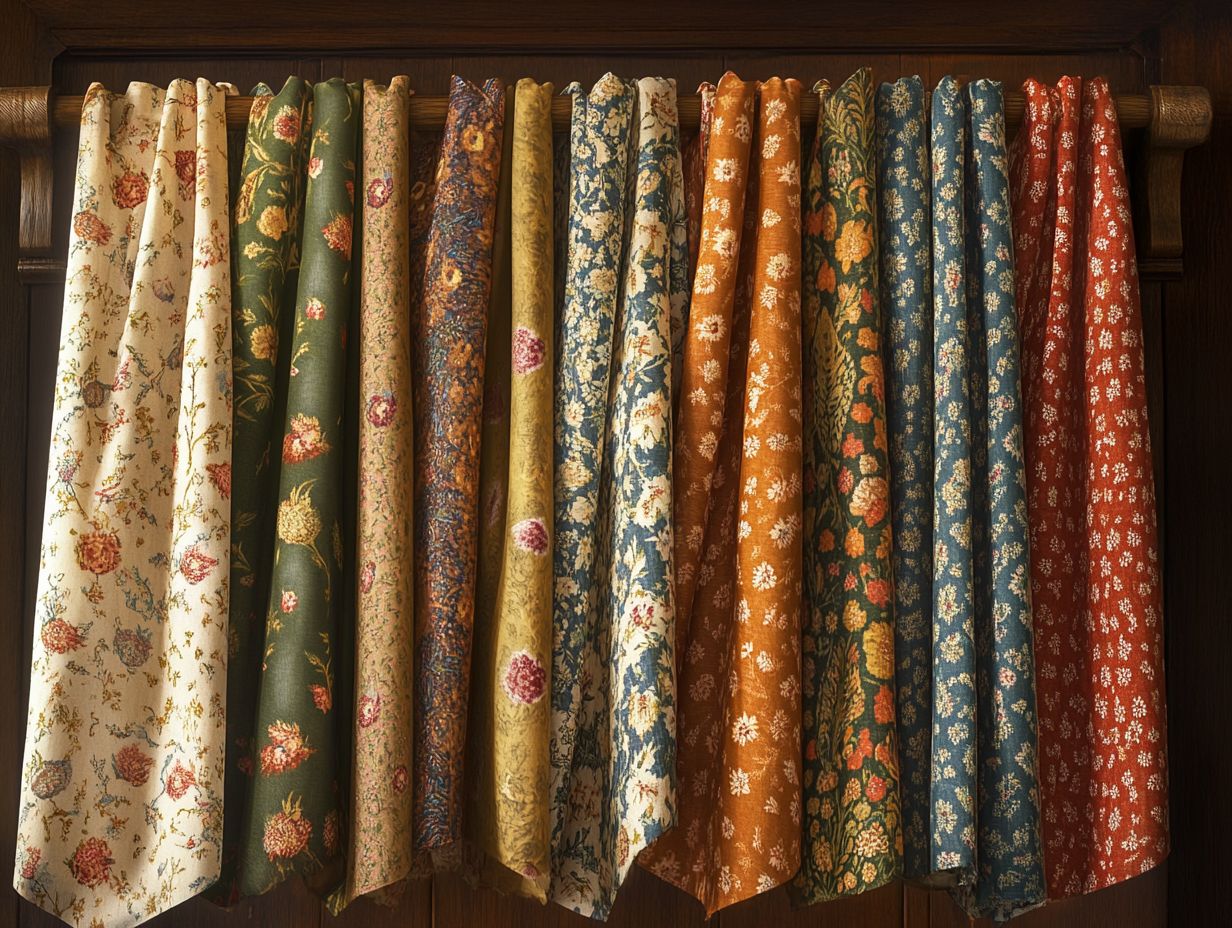
Silk is a luxurious fabric choice for vintage upholstery. It is known for its soft texture and rich luster, which elevate any design.
This stunning material catches light beautifully, adding depth to patterns like damask, brocade, and floral designs. These patterns evoke a delightful sense of nostalgia.
Silk is durable and fade-resistant, allowing your vintage pieces to last. To keep it looking its best, avoid direct sunlight and vacuum regularly with a soft brush.
For stains, opt for professional cleaning. This care ensures silk remains a centerpiece in your vintage decor.
Velvet
Velvet is a sumptuous fabric that adds depth and richness to your vintage projects. It’s a preferred choice for infusing a luxurious feel into any room.
The texture invites you to touch it, creating a sensory experience. Velvet complements styles from mid-century modern to art deco, offering endless design possibilities.
Pairing velvet with vintage patterns like floral brocades or geometric prints creates an eclectic aesthetic. This combination showcases a curated design approach that sparks conversations!
How to Incorporate Vintage Fabric Patterns in Your Home
Incorporating vintage fabric patterns requires an eye for fabric selection and an understanding of design trends that reflect your style.
When updating a vintage chair, sofa, or curtains, consider how upholstery materials and colors can transform your living space. Create an ambiance that is both unique and inviting.
Your choices will elevate the aesthetic and weave a narrative of character and warmth throughout your home. Explore the best vintage fabric resources online and start your vintage fabric adventure today!
Tips for Mixing and Matching Patterns
Mixing and matching patterns in vintage fabric demands a careful selection and a sense of balance to cultivate a cohesive look that enhances your decor without overwhelming it. By fusing various fabric styles think floral prints alongside geometric designs you can craft an eclectic yet harmonious atmosphere that reflects your personal taste.
To navigate this artistic journey successfully, consider essential strategies centered on color coordination and scale. Start by selecting a dominant color palette that weaves the different patterns together, ensuring that colors complement one another rather than clash.
Incorporating varied scales will elevate your composition. Pairing a large floral design with smaller geometric shapes adds depth and intrigue. Utilizing neutral backgrounds, such as soft beige or muted gray, helps unify the mix, preventing the fabrics from competing for attention.
Imagine a brightly patterned vintage chair accented with a modestly scaled pillow; this combination creates a striking yet inviting focal point in any room. This approach not only showcases your personality but also achieves a beautiful visual harmony.
Choosing the Right Colors
Choosing the right colors for vintage fabric patterns is crucial for crafting a cohesive and inviting space, whether your preference leans towards vibrant hues or earthy tones. By understanding how different colors interact, you can elevate your upholstery projects, ensuring that each piece harmonizes beautifully with your home s overall design.
Color theory explains how colors work together and is your secret weapon in this selection process, significantly influencing mood and style. For example, warm colors like reds and oranges can spark conversation and create a cozy atmosphere, while cool shades such as blues and greens tend to evoke a sense of relaxation and tranquility.
When exploring popular palettes, combinations like teal and coral are particularly striking, offering a refreshing twist on classic designs. Alternatively, pairing mustard yellows with deep burgundies evokes a nostalgic vibe, perfectly blending traditional elements with contemporary flair.
The right color combinations enhance aesthetic appeal, reflect your personal style, and evoke the emotions you want to feel within your space.
Frequently Asked Questions
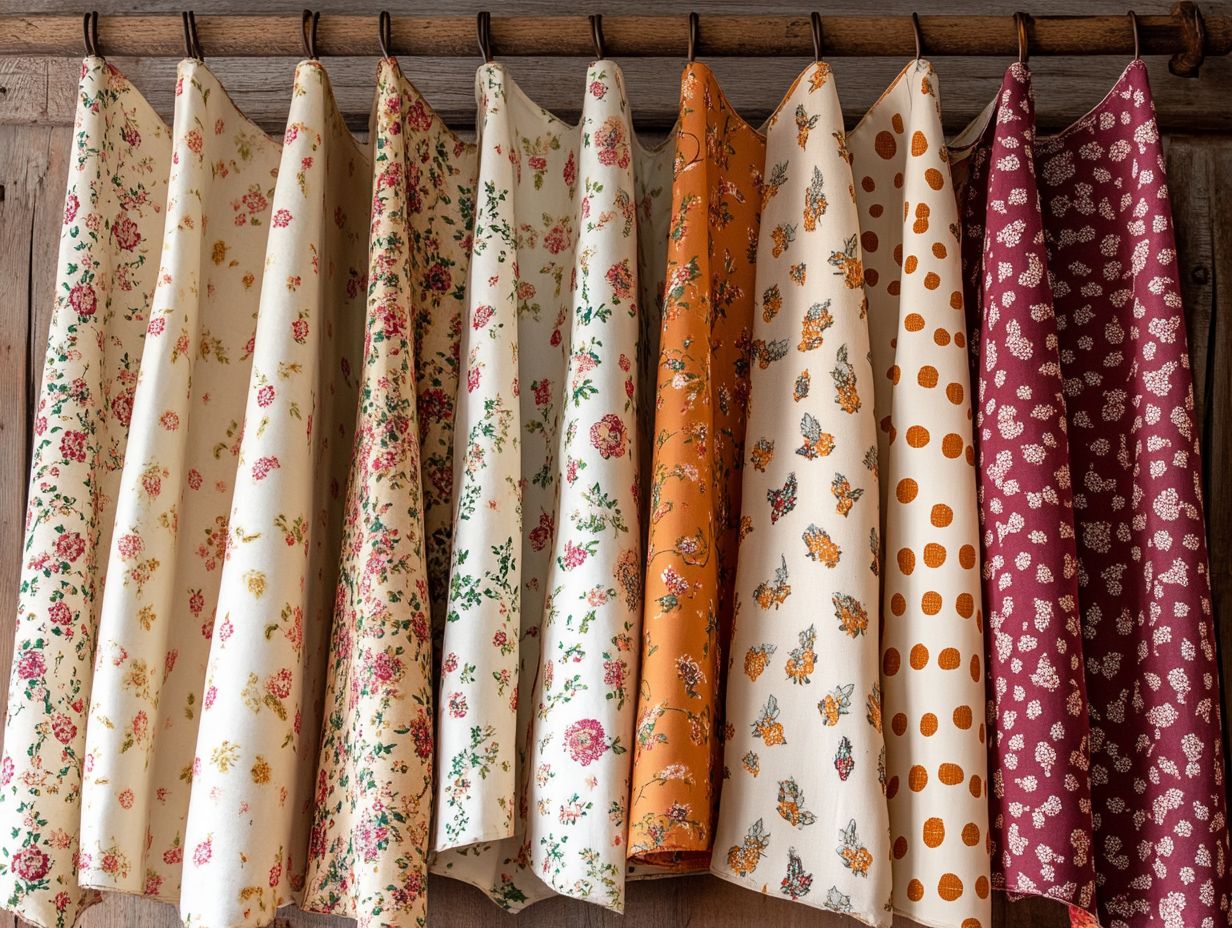
What are the best vintage fabric patterns for curtains?
Some of the best vintage fabric patterns for curtains include floral prints, gingham, toile, and paisley.
What makes these vintage fabric patterns ideal for curtains?
These patterns work wonders for adding charm and elegance to your space, and their timeless appeal never goes out of style.
Can vintage fabric patterns be used for modern homes?
Yes, vintage fabric patterns can enhance modern homes by adding a unique and nostalgic touch to the d cor. They can be mixed and matched with modern elements for a perfect blend of old and new.
Are these vintage fabric patterns suitable for all types of curtains?
Yes, they are versatile and great for drapes, panels, or valances.
Where can I find the best vintage fabric patterns for curtains?
You can find a wide selection of vintage fabric patterns at antique stores, thrift shops, and online marketplaces. You can also consider making your own curtains with vintage fabric for a truly unique look.
What are some tips for choosing the perfect vintage fabric pattern for curtains?
When choosing a vintage fabric pattern for curtains, consider the room’s color scheme, the size and scale of the pattern, and the overall style of your home. Also, inspect the fabric for any damages or stains before purchasing.

